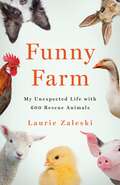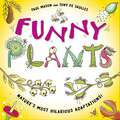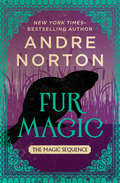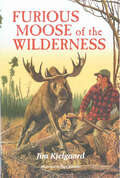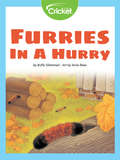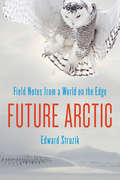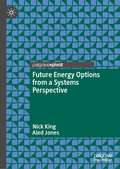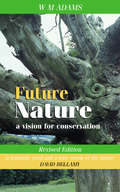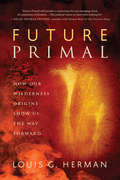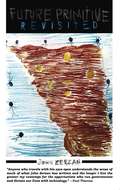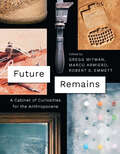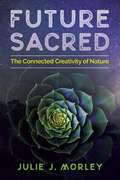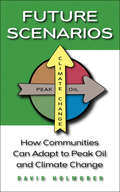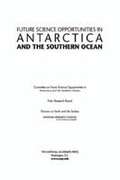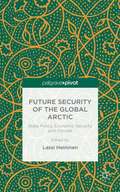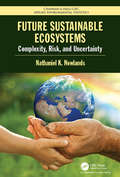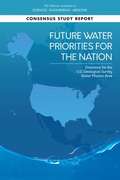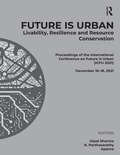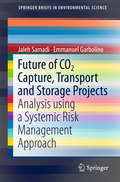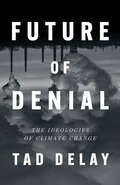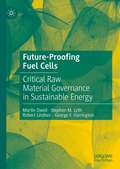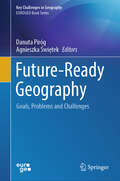- Table View
- List View
Funky Fungi: 30 Activities for Exploring Molds, Mushrooms, Lichens, and More (Young Naturalists #8)
by Alisha GabrielFungi are everywhere! They live in the coldest corner of Antarctica and on hot, sandy desert dunes. They're in the air you breathe and the food you eat. But fungi are more than pizza toppings. They form partnerships with plants and help us clean up our planet through bioremediation. Some fungi eat our crops; others protect them. Some fungi cause diseases; others cure them. Some are bigger than you; others are so tiny you need a microscope to see them. And now, people are finding ways to use fungi to make furniture, building materials, and even sneakers.So grab your gear and let's go find some Funky Fungi.
Funny Farm: My Unexpected Life with 600 Rescue Animals
by Laurie ZaleskiAn inspiring and moving memoir of the author's turbulent life with 600 rescue animals.Laurie Zaleski never aspired to run an animal rescue; that was her mother Annie’s dream. But from girlhood, Laurie was determined to make the dream come true. Thirty years later as a successful businesswoman, she did it, buying a 15-acre farm deep in the Pinelands of South Jersey. She was planning to relocate Annie and her caravan of ragtag rescues—horses and goats, dogs and cats, chickens and pigs—when Annie died, just two weeks before moving day. In her heartbreak, Laurie resolved to make her mother's dream her own. In 2001, she established the Funny Farm Animal Rescue outside Mays Landing, New Jersey. Today, she carries on Annie’s mission to save abused and neglected animals.Funny Farm is Laurie’s story: of promises kept, dreams fulfilled, and animals lost and found. It’s the story of Annie McNulty, who fled a nightmarish marriage with few skills, no money and no resources, dragging three kids behind her, and accumulating hundreds of cast-off animals on the way. And lastly, it's the story of the brave, incredible, and adorable animals that were rescued. Although there are some sad parts (as life always is), there are lots of laughs.
Funny Plants: Laugh-out-loud nature facts! (Funny Nature #3)
by Paul MasonHeaps of funny facts and cartoons about the plant world's most hilarious adaptations!Plants have developed some downright strange features and behaviours to survive day in and day out. This book's lively artwork and side-splitting jokes uncover the awesome science of the plant world. Meet the stickiest, the stinkiest, the trickiest and of course the absolutely funniest plants on planet Earth!Funny Nature is a series of books presenting science learning through laughter. Brought to you by the author and illustrator of The Poo That Animals Do, this series covers science topics including evolution, adaptation, habitats, anatomy, physiology, life cycles and much more! Perfect for fans of facts and fun aged 6+.Books in the Funny Nature series:Funny BeastsFunny BugsFunny DinosaursFunny Plants
Fur Magic: Steel Magic, Octagon Magic, And Fur Magic (The Magic Sequence #3)
by Andre NortonA boy's encounter with powerful tribal magic transforms him into his spirit animal--and lands him in the middle of a war between humans and beasts with supernatural powers When his father is called to active duty in Vietnam, Cory Alder leaves Florida to live with his adopted Native American uncle, Jasper. Jasper's Idaho ranch is like a foreign country. Cory is afraid of the cougars, bears, and wolves; he doesn't like the big mountains and doubts he'll ever be able to ride a wild horse. Then he meets an old Nez Perce Medicine Man called Black Elk, who catapults Cory into an alternate universe where animals live in tribes, hunt, and go on the warpath. Transformed into a beaver called Yellow Shell, he learns to speak their language and discovers that they all fear the legendary Changer, who plots to reshape the creatures of both the human and animal realms and use them for his own nefarious ends. With two worlds hanging in the balance, Cory must rely on courage and instinct to defeat this cunning enemy and be restored to his human form. Is he strong enough to stand up to the Changer and overcome his own fear of the unknown? Fur Magic is the 2nd book in the Magic Sequence, but you may enjoy reading the series in any order.
Furious Moose of the Wilderness
by Jim KjelgaardIndependent young wilderness trapper, Pete Gant, met the challenge of a monstrous bull moose with courage and skill-after he let it chase him up a tree and keep him there all night! He was not so sure of his tactics when it came to dealing with Hailey Zulski, tiny and teasing, who could nevertheless work steadfastly beside her invalid father, a refugee from Poland, on their rugged sheep ranch. This was especially the case when Hailey said she would never speak to Pete again if he killed the furious moose in a spirit of hatred and revenge, when he knew perfectly well that she helped her father stock their thin larder with game to tide them over the winter. Then there was the question of books. Pete could read all right, but he needed to know what he was reading, the way the Zulskis did. This outdoor adventure story has a most unusual slant, but, with Jim Kjelgaard as the author, the reader is assured of stirring action and a true feel of the wilderness that is echoed in Mort Kunstler's fine illustrations.
Furries in a Hurry
by Buffy SilvermanDid you know that a woolly bear is a type of caterpillar? People have sometimes used these caterpillars to predict the weather by looking at their stripes! Learn about these interesting creatures and what their life is like before they make cocoons and morph into their final form—the yellow tiger moth!
Futility, Or The Wreck of the Titan: Or, Futility
by Morgan RobertsonWhen the "unsinkable" ship the Titan strikes an iceberg, John Rowland, a former naval lieutenant, heroically saves the life of a young girl as the ship founders and eventually sinks, leaving them stranded in the desolate and frigid North Atlantic.Be it mystery, romance, drama, comedy, politics, or history, great literature stands the test of time. ClassicJoe proudly brings literary classics to today's digital readers, connecting those who love to read with authors whose work continues to get people talking. Look for other fiction and non-fiction classics from ClassicJoe.
Future Arctic: Field Notes from a World on the Edge
by Edward StruzikIn one hundred years, or even fifty, the Arctic will look dramatically differthan it does today. As polar ice retreats and animals and plants migrate northward, the arctic landscape is morphing into something new and very differfrom what it once was. While these changes may seem remote, they will have a profound impact on a hof global issues, from international politics to animal migrations. In Future Arctic, journalist and explorer Edward Struzik offers a clear-eyed look at the rapidly shifting dynamics in the Arctic region, a harbinger of changes that will reverberate throughout our entire world.Future Arctic reveals the inside story of how politics and climate change are altering the polar world in a way that will have profound effects on economics, culture, and the environmas we know it. Struzik takes readers up mountains and cliffs, and along for the ride on snowmobiles and helicopters, sailboats and icebreakers. His travel companions, from wildlife scientists to military strategists to indigenous peoples, share diverse insights into the science, culture and geopolitical tensions of this captivating place. With their help, Struzik begins piecing together an environmental puzzle: How might the land's miconic species—caribou, polar bears, narwhal—survive? Where will migrating birds flock to? How will ocean currents shift? And what fundamental changes will oil and gas exploration have on economies and ecosystems? How will vast unclaimed regions of the Arctic be divided?A unique combination of extensive on-the-ground research, compelling storytelling, and policy analysis, Future Arctic offers a new look at the changes occurring in this remote, mysterious region and their far-reaching effects.
Future Drive: Electric Vehicles And Sustainable Transportation
by Daniel Sperling A. F. Burke Patricia M. Davis Mark A. DelucchiIn Future Drive, Daniel Sperling addresses the adverse energy and environmental consequences of increased travel, and analyzes current initiatives to suggest strategies for creating a more environmentally benign system of transportation. Groundbreaking proposals are constructed around the idea of electric propulsion as the key to a sustainable transportation and energy system. Other essential elements include the ideas that: *improving technology holds more promise than large-scale behavior modification *technology initiatives must be matched with regulatory and policy initiatives *government intervention should be flexible and incentive-based, but should also embrace selective technology-forcing measures *more diversity and experimentation is needed with regard to vehicles and energy technologies Sperling evaluates past and current attempts to influence drivers and vehicle use, and articulates a clear and compelling vision of the future. He formulates a coherent and specific set of principles, strategies, and policies for redirecting the United States and other countries onto a new sustainable pathway.
Future Energy Options from a Systems Perspective
by Aled Jones Nick KingThis book is an exploration of energy and its unique role to date as one of the fundamental enabling and controlling factors in human development and progress at the scale of global civilization, and how it will be fundamental to the type of future that collective humanity is likely to experience. The first section provides a contextual overview of energy and human civilization through a chronological description of how human energy use has evolved over time and led to the current ‘energy bind’. The second section explores what this energy bind might mean for our future energy choices when trying to meet the various challenges of dwindling resources, costs, and climate change, through exploration of three broad systems-based scenarios for the human ‘energy future’. The final section draws conclusions as to which scenario is most achievable and desirable, and what this might mean for longer-term human prospects.
Future Nature: A Vision for Conservation
by W.M. AdamsThe countryside is changing faster than ever. Fifty years of conservation achievements in the UK are now being confronted by a new complexion of economic forces that are driving change in the countryside. At the same time new ideas in conservation are altering the role that conservation is being asked to play in negotiating the transition from past to future. This revised edition of Bill Adams classic work Future Nature tackles the new challenges in the countryside and wildlife conservation head-on through a new Introduction and Postscript with updated arguments about naturalness and our social engagement with nature, and complemented by a new Foreword by Adrian Phillips. Concepts such as biodiversity and sustainability, and changes in our understanding, appreciation and concern for nature, offer unprecedented opportunities. Bill Adams explores the scientific, cultural and economic significance of conservation. He argues that conservation must move beyond the boundaries of parks and reserves to embrace the whole countryside. The importance of conservation for the future is enormous. It holds the potential to create new spaces for nature, both in the landscape and in our lives and imaginations. This factual, beautifully written and thought-provoking book offers a fundamental reassessment of conservation, its importance, and how to achieve it. Published with BANC
Future Primal
by Louis G. HermanHow should we respond to our converging crises of violent conflict, political corruption, and global ecological devastation? In this sweeping, big-picture synthesis, Louis G. Herman argues that for us to create a sustainable, fulfilling future, we need to first look back into our deepest past to recover our core humanity. Important clues for recovery can be found in the lives of traditional San Bushman hunter-gatherers of South Africa, the closest living relatives to the ancestral African population from which all humans descended. Their culture can give us a sense of what life was like during the tens of thousands of years when humans lived in wilderness, without warfare, walled cities, or slavery. Herman suggests we draw from the experience of the San and other earth-based cultures and weave their wisdom together with the scientific story of an evolving universe to help create something radically new -- an earth-centered, planetary politics with the personal truth quest at its heart.
Future Primitive Revisited
by John Zerzan"Zerzan's writing is sharp, uncompromising, and tenacious." -- Derrick Jensen "John Zerzan's importance does not only consist in his brilliant intelligence, his absolute clearness of analysis and his unequalled dialectical synthesis that clarifies even the most complicated questions, but also in the humanity that fills his thoughts of resistance. Future Primitive Revisited is one more precious gift for us all."--Enrico Manicardi, author of Liberi dalla Civiltá (Free from Civilization) "Anyone who travels with his eyes open understands the sense of much of what you have written, and the longer I live the greater my contempt for the opportunists who run governments and dictate our lives with technology."--Paul Theroux "Of course we should go primitive. This doesn't mean abandoning material needs, tools, or skills, but ending our obsession with such concerns. Declaring for community, our true origin: personal autonomy, trust, mutual support in pursuit of all the joys and troubles of life. Society was a trap--massive, demanding, impersonal and debilitating from day one. So hurry back to the community, friends, and welcome all the consequences of such an orientation. The reasons for fear and despair will only multiply if we remain in this brutal and dangerous state of civilization."--Blok 45 publishing, Belgrade As our society is stricken with repeated technological disasters, and the apocalyptic problems that go with them, the "neo-primitivist" essays of John Zerzan seem more relevant than ever. "Future Primitive," the core innovative essay of Future Primitive Revisited, has been out of print for years. This new edition is updated with never-before-printed essays that speak to a youthful political movement and influential writers such as Derrick Jensen and Paul Theroux. An active participant in the contemporary anarchist resurgence, John Zerzan has been an invited speaker at both radical and conventional events on several continents. His weekly Anarchy Radio broadcast streams live on KWVA radio.
Future Remains: A Cabinet of Curiosities for the Anthropocene
by Gregg Mitman Marco Armiero Robert EmmettWhat can a pesticide pump, a jar full of sand, or an old calico print tell us about the Anthropocene—the age of humans? Just as paleontologists look to fossil remains to infer past conditions of life on earth, so might past and present-day objects offer clues to intertwined human and natural histories that shape our planetary futures. In this era of aggressive hydrocarbon extraction, extreme weather, and severe economic disparity, how might certain objects make visible the uneven interplay of economic, material, and social forces that shape relationships among human and nonhuman beings? Future Remains is a thoughtful and creative meditation on these questions. The fifteen objects gathered in this book resemble more the tarots of a fortuneteller than the archaeological finds of an expedition—they speak of planetary futures. Marco Armiero, Robert S. Emmett, and Gregg Mitman have assembled a cabinet of curiosities for the Anthropocene, bringing together a mix of lively essays, creatively chosen objects, and stunning photographs by acclaimed photographer Tim Flach. The result is a book that interrogates the origins, implications, and potential dangers of the Anthropocene and makes us wonder anew about what exactly human history is made of.
Future Sacred: The Connected Creativity of Nature
by Glenn Aparicio Parry Julie J. MorleyReveals how our survival depends on embracing complexity consciousness and relating to nature and all life as sacred • Rejects the “survival of the fittest” narrative in favor of sacred symbiosis, creative cooperation, interdependence and complex thinking • Provides examples from complexity studies, cultural history, philosophy, indigenous spirituality, biomimicry, and ecology to show how nature’s intelligence and creativity abound everywhere • Documents how indigenous cultures lived in relative harmony with nature because they perceived themselves as part of the “ordered whole” of all life In Future Sacred, Julie J. Morley offers a new perspective on the human connection to the cosmos by unveiling the connected creativity and sacred intelligence of nature. She rejects the “survival of the fittest” narrative--the idea that survival requires strife--and offers symbiosis and cooperation as nature’s path forward. She shows how an increasingly complex world demands increasingly complex consciousness. Our survival depends upon embracing “complexity consciousness,” understanding ourselves as part of nature, as well as relating to nature as sacred. Morley begins by documenting how indigenous cultures lived in relative harmony with nature because they perceived themselves as part of the “ordered whole” of all life--until modernity introduced dualistic thinking, thus separating mind from matter, and humans from nature. The author deconstructs the fallacy behind social and neo-Darwinism and the materialist theories of “dead matter” versus those that offer a connection with the sentient mind of nature. She presents evidence from complexity studies, cultural history, philosophy, indigenous spirituality, biomimicry, and ecology, highlighting the idea that nature’s intelligence and creativity abound everywhere--from cells to cetaceans, from hydrogen to humans, from sunflowers to solar panels--and that all sentient beings contribute to the evolution of life as a whole, working together in sacred symbiosis. Morley concludes that our sacred future depends on compassionately understanding and integrating multiple intelligences, seeing relationships and interdependence as fundamental and sacred, as well as honoring the experiences of all sentient beings. Instead of “mastery over nature,” we must shift toward synergy with nature--and with each other as diverse expressions of nature’s creativity.
Future Scenarios
by David HolmgrenIn Future Scenarios, permaculture co-originator and leading sustainability innovator David Holmgren outlines four scenarios that bring to life the likely cultural, political, agricultural, and economic implications of peak oil and climate change, and the generations-long era of "energy descent" that faces us. "Scenario planning," Holmgren explains, "allows us to use stories about the future as a reference point for imagining how particular strategies and structures might thrive, fail, or be transformed." Future Scenarios depicts four very different futures. Each is a permutation of mild or destructive climate change, combined with either slow or severe energy declines. Probable futures, explains Holmgren, range from the relatively benign Green Tech scenario to the near catastrophic Lifeboats scenario. As Adam Grubb, founder of the influential Energy Bulletin Web site, says, "These aren't two-dimensional nightmarish scenarios designed to scare people into environmental action. They are compellingly fleshed-out visions of quite plausible alternative futures, which delve into energy, politics, agriculture, social, and even spiritual trends. What they do help make clear are the best strategies for preparing for and adapting to these possible futures." Future Scenarios provides brilliant and balanced consideration of the world's options and will prove to be one of the most important books of the year.
Future Science Opportunities in Antarctica and the Southern Ocean
by Committee on Future Science Opportunities in Antarctica the Southern OceanAntarctica and the surrounding Southern Ocean remains one of the world's last frontiers. Covering nearly 14 million km² (an area approximately 1. 4 times the size of the United States), Antarctica is the coldest, driest, highest, and windiest continent on Earth. While it is challenging to live and work in this extreme environment, this region offers many opportunities for scientific research. Ever since the first humans set foot on Antarctica a little more than a century ago, the discoveries made there have advanced our scientific knowledge of the region, the world, and the Universe--but there is still much more to learn. However, conducting scientific research in the harsh environmental conditions of Antarctica is profoundly challenging. Substantial resources are needed to establish and maintain the infrastructure needed to provide heat, light, transportation, and drinking water, while at the same time minimizing pollution of the environment and ensuring the safety of researchers. "Future Science Opportunities in Antarctica and the Southern Ocean" suggests actions for the United States to achieve success for the next generation of Antarctic and Southern Ocean science. The report highlights important areas of research by encapsulating each into a single, overarching question. The questions fall into two broad themes: (1) those related to global change, and (2) those related to fundamental discoveries. In addition, the report identified key science questions that will drive research in Antarctica and the Southern Ocean in coming decades, and highlighted opportunities to be leveraged to sustain and improve the U. S. research efforts in the region.
Future Security of the Global Arctic: State Policy, Economic Security And Climate
by Lassi HeininenIn the globalized Arctic there has been a transformation from military security to human security. Climate change, the utilization of Arctic resources and other global challenges have caused the Arctic 'paradox' and a need to redefine security.
Future Sustainable Ecosystems: Complexity, Risk, and Uncertainty (Chapman & Hall/CRC Applied Environmental Statistics #11)
by Nathaniel K NewlandsFuture Sustainable Ecosystems: Complexity, Risk, Uncertainty provides an interdisciplinary, integrative overview of environmental problem-solving using statistics. It shows how statistics can be used to solve diverse environmental and socio-economic problems involving food, water, energy scarcity, and climate change risks. It synthesizes interdisciplinary theory, concepts, definitions, models and findings involved in complex global sustainability problem-solving, making it an essential guide and reference. It includes real-world examples and applications making the book accessible to a broader interdisciplinary readership. Discussions include a broad, integrated perspective on sustainability, integrated risk, multi-scale changes and impacts taking place within ecosystems worldwide. State-of-the-art statistical techniques, including Bayesian hierarchical, spatio-temporal, agent-based and game-theoretic approaches are explored. The author then focuses on the real-world integration of observational and experimental data and its use within statistical models.
Future Water Priorities for the Nation: Directions For The U. S. Geological Survey Water Mission Area
by Engineering Medicine National Academies of SciencesSolving problems related to use of water resources will be of paramount importance in coming decades as increasing pressure from growing populations, climate change, extreme weather, and aging water-related infrastructure threaten water availability and quality. The Water Mission Area (WMA) of the U.S. Geological Survey (USGS) has a long-established reputation for collecting and delivering high-quality, unbiased scientific information related to the nation’s water resources. WMA observations help inform decisions ranging from rapid responses during emergencies such as hurricanes, floods, and forest fires, to the long-term management of water resources. Produced at the request of USGS, this report identifies the nation’s highest-priority water science and resources challenges over the next 25 years. Future Water Priorities for the Nation summarizes WMA’s current water science and research portfolio, and recommends strategic opportunities for WMA to more effectively address the most pressing challenges.
Future is Urban: Proceedings of the International Conference on FUTURE IS URBAN: Livability, Resilience and Resource Conservation (ICFU 2021), December 16–18, 2021
by R. Parthasarathy Utpal SharmaCities have played an important role in our lives since the dawn of civilization. However, cities are slowly becoming overwhelmed and therefore intervention is desirable towards green, blue and egalitarian nature. Even with current urban issues, we must rise to the occasion as professionals to create cities that are social, cities that take care of the environment, and cities that are digital. Increased citizen participation is indispensable in this process. The ‘International Conference on Future is Urban (IFCU’ 21) Dec 16-18, 2021, Ahmedabad, India’, takes into account Livability, Resilience & Resource Conservation for planning Future and cities in future.
Future of CO2 Capture, Transport and Storage Projects: Analysis Using A Systemic Risk Management Approach (SpringerBriefs in Environmental Science)
by Emmanuel Garbolino Jaleh SamadiThis book presents a summary of a three-year research project on risk management for the Capture, Transport and Storage of CO2 (CTSC), offering an in-depth study on complex sociotechnical systems and systemic modeling. Approaching CTSC as a complex sociotechnical system, this book proposes systemic modeling as a decision-making aid. It offers a means of decision-making for the development of CTSC projects in the real-world context, where the future of the technology is uncertain. Risk management is considered as a means of control that can provide a control structure for the whole system.The risks associated with CTSC are not exclusively technical in nature; CTSC also faces a number of further uncertainties, from development to commercial scales.A major question concerning CTSC at the current scale of development is: "What are the factors explaining the success or failure of CTSC projects in different contexts?" In order to answer this question, the book proposes a systemic risk management framework based on the system dynamics and STAMP (Systems-Theoretic Accident Model and Processes) concepts.
Future of Denial: The Ideologies of Climate Change
by Tad DeLay"Tad DeLay is one of the most important and disquieting theorists of consciousness and politics writing today. His work is indispensable."—China Miéville, author of OctoberCapitalism is an ecocidal engine constantly regenerating climate change denialThe age of denial is over, we are told. Yet emissions continue to rise while gimmicks, graft, and green- washing distract the public from the climate violence suffered by the vulnerable. This timely, interdisciplinary contribution to the environmental humanities draws on the latest climatology, the first shoots of an energy transition, critical theory, Earth&’s paleoclimate history, and trends in border violence to answer the most pressing question of our age: Why do we continue to squander the short time we have left?The symptoms suggest society&’s inability to adjust is profound. Near Portland, militias incapable of accepting that the world is warming respond to a wildfire by hunting for imaginary left-wing arsonists. Europe erects nets in the Aegean Sea to capture migrants fleeing drought and war. An airline claims to be carbon neutral thanks to bogus cheap offsets. Drone strikes hit people living along the aridity line. Yes, Exxon knew as early as the 1970s, but the fundamental physics of carbon dioxide warming the Earth was already understood before the American Civil War.Will capitalists ever voluntarily walk away from hundreds of trillions of dollars in fossil fuels unless they are forced to do so? And, if not, who will apply the necessary pressure?
Future-Proofing Fuel Cells: Critical Raw Material Governance in Sustainable Energy
by Robert Lindner Martin David Stephen M. Lyth George F. HarringtonAs the world accelerates towards a renewable energy transition, the demand for critical raw materials (CRMs) for energy generation, conversion, and storage technologies is seeing a drastic increase. Such materials are not only subject to limited supply and extreme price volatility but can also represent serious burdens to the environment, to human health, and also to socio-political systems. Taking an interdisciplinary perspective, this book provides a novel perspective on the discussion about material dependencies of energy technologies. It examines CRMs use in fuel cells, an emerging energy conversion technology, and discusses governance strategies for early-stage fuel cell development to predict and avoid potential issues. This will be an invaluable resource for researchers in energy studies, engineering, sociology and political science as well as those with a general interest in this field looking for an accessible overview.
Future-Ready Geography: Goals, Problems and Challenges (Key Challenges in Geography)
by Danuta Piróg Agnieszka ŚwiętekThis book presents research on how geography as a science, as a university degree and as a school subject can get ready for the “future.” Today's world is in a state of permanent and radical change which is affecting society, science and the economy in equal measure. The concurrent processes of globalisation, digitisation, and integration shape and constantly modify the development factors and generate multidirectional social changes. Growing global issues related to climate change, food security, depletion of conventional energy sources, conflicts and wars, refugee crisis and pandemic open up new issues for geographic investigations as well as reinforce the need to examine old research topics covering a variety of subdisciplines. That is why the term “future-ready” is being more frequently used in discourses on geographic research. In particular, geographic education at schools should be subject to discussion and reflection as this is where our learners are primed to understand the world around them. The chapters of this book spread the knowledge about the role of geography in preparing the society for the future. The book responds to environmental, socio-economic, and political issues of global, regional and local impact. It provides methods, techniques and tools of data collection and analysis which efficiently support geographers in future-oriented research and help in forecasting environmental and social changes. Finally, this volume also discusses how to reinforce the position of geography as science and school subject today and in the future.

